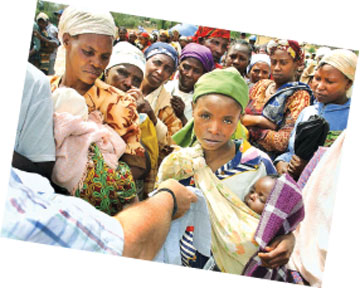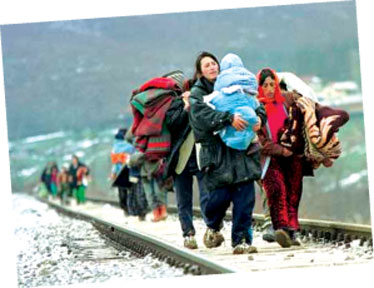Ensuring a new life for refugees, a global challenge
World Refugee Day on June 20:
By Pramod DE SILVA
Did you know that every minute, eight people around the world are
forced to flee their homes due to war and persecution? That 43 million
people worldwide have been displaced from their homes and sometimes,
their own countries? With wars and conflicts raging on practically all
continents and other modern challenges such as climate change affecting
millions of people, we face the bleak prospect of having more refugees
in the coming decades.
Who exactly is a refugee? The 1951 Refugee Convention establishing
the United Nations High Commissioner for Refugees (UNHCR) spells out
that a refugee is someone who “owing to a well-founded fear of being
persecuted for reasons of race, religion, nationality, membership of a
particular social group or political opinion, is outside the country of
his nationality, and is unable to, or owing to such fear, is unwilling
to avail himself of the protection of that country.”
The number of refugees of concern to UNHCR stood at 10.5 million
refugees at the beginning of 2011, down slightly from a year earlier. A
further 4.8 million registered refugees are looked after in 60 camps in
the Middle East by United Nations Relief and Works Agency for Palestine
Refugees in the Near East (UNRWA), which was set up in 1949 to care for
displaced Palestinians. The world's largest source countries (country of
origin) for refugees include Afghanistan, Iraq, and Sierra Leone.
Among the countries hosting the highest number of refugees are
Pakistan, Syria, Jordan, Iran, and Guinea. The largest refugee camp in
the world is however located in Kenya - the Dadaab camp in the
north-east of the country accommodated over 460,000 refugees at the end
of 2011, mostly from Somalia. But this is not the end of the story.
People can be displaced in their own countries – they are called
Internally Displaced People.
At the end of 2009, there were an estimated 27 million IDPs around
the world and UNHCR was helping about 14.7 million of them in 22
countries, including the three with the largest IDP populations - Sudan,
Colombia and Iraq. Conflict is not the only reason – natural disasters
(and climate change) can cause mass displacement of people, as witnessed
during the 2004 tsunami.
Environmental refugees
 According to UN predictions, there could be as many as 50 million
“environmental refugees” in the next few decades. Sri Lanka has a good
track record with regard to the resettlement of those displaced due to
conflict and natural disasters. According to UN predictions, there could be as many as 50 million
“environmental refugees” in the next few decades. Sri Lanka has a good
track record with regard to the resettlement of those displaced due to
conflict and natural disasters.
Only a few hundred people are left to be resettled just three years
after a conflict that displaced nearly 300,000. Most, if not all, of
tsunami-hit families too have been resettled. There still are Sri Lankan
refugees in India, but many of these families have expressed an interest
in coming back to the land of their birth. Some have already made that
move.
Stateless persons are in another category. In other words, they are
people who do not have a country to call their own. According to the
UNHCR, statelessness occurs for a variety of reasons including
discrimination against minority groups in nationality legislation,
failure to include all residents in the body of citizens when a state
becomes independent (state succession) and conflicts of laws between
states. Statelessness is a problem that affects an estimated 12 million
people worldwide. They are not refugees or IDPs but they too are often
denied their rights.
Finally, we often hear the term ‘asylum seekers’, which should not be
confused with the term refugee. An asylum-seeker is someone who says he
or she is a refugee, but whose claim has not yet been definitively
evaluated. They may be genuinely fleeing their home countries due to a
conflict situation or political reasons, but the world is confronting
the phenomenon of illegal economic asylum seekers (basically economic
migrants) who leave their countries to seek greener pastures in Western
nations.
They are known to pay thousands of dollars to human smugglers to take
them by boat to affluent countries. There is often no evidence that
these persons would be subject to persecution by their home States.
Nearly one million people are in the asylum seeker category.
During 2010 - 223,000 asylum seekers were granted refugee status. New
applications registered during the year fell by about 10 p.c. to
850,000, by far the largest share originating from Zimbabwe, followed by
Somalia and the Democratic Republic of Congo. The picture is bleak on
all three counts. But it is important not to lose hope, the only thing
that drives these unfortunate people to aspire for a better life.
 They generally have three choices in this endeavour: repatriation to
their home country if and when the conflict (or any other factor that
drove them away) is resolved; resettlement (if IDPs) and local
integration (either in a foreign country or in another place in their
own country). They generally have three choices in this endeavour: repatriation to
their home country if and when the conflict (or any other factor that
drove them away) is resolved; resettlement (if IDPs) and local
integration (either in a foreign country or in another place in their
own country).
This year, the World Refugee Day that falls on June 20 focuses on
this last category, under the theme “A New Home, A New Life”. The idea
is that it is possible to begin a new life in another country, provided
that they are granted all their rights by the host country. The World
Refugee Day was first marked in 2001, on the fiftieth anniversary of the
1951 Convention Relating to the Status of Refugees that established the
UNHCR. Nearly 150 countries have signed this Convention.
International law
Refugee status is greatly valued for the rights that it bestows under
international law. A refugee is entitled to reside, at least
temporarily, in the host country and is protected. This prohibits the
deportation of refugees to places where their lives or freedoms could be
in danger. Host states are also obliged to offer civil and economic
rights, in particular the right to work. Refugees enjoy access to social
services and protection of national laws. By contrast, illegal migrant
workers have no recourse to international law to enforce their rights.
UN High Commissioner for Refugees António Guterres has warned that
factors causing mass population flight are growing and over the coming
decade more people on the move will become refugees or displaced within
their own country. In comments marking the launch in New York of “The
State of the World's Refugees: In Search of Solidarity,” Guterres said
displacement from conflict was becoming compounded by a combination of
causes, including climate change, population growth, urbanisation, food
insecurity, water scarcity and resource competition.
Moreover, 80 percent of today's refugees live in the developing world
that does not have additional resources to deal with an extra influx of
people. The world has to address this problem through international
cooperation and political will.
The UNHCR has suggested providing more resettlement opportunities for
refugees in the industrialised world (some countries have a fortress
mentality that rejects outsiders, especially genuine refugees), focusing
development cooperation projects to foster sustainable voluntary return
or local integration, and supporting host communities.
Refugees who are integrated firmly to host communities can indeed
begin a new life in a new home and enrich the community in return. They
should not necessarily be perceived of as a burden.
The refugee problem is a blot on humanity. But it is unlikely to go
away if the world’s conflicts are not resolved or if the world does not
face challenges such as climate change.
|

